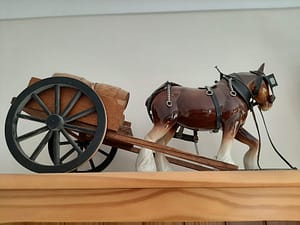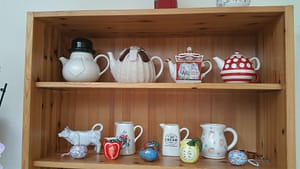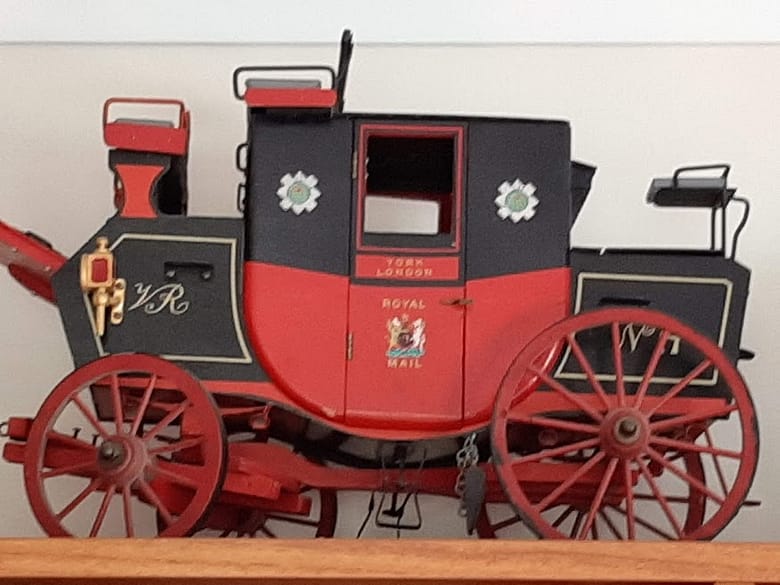I’ve made a feature of the small collections I have. When you declutter look out for objects that really stand out. Look out for objects that you can group together to decorate a room.
My collections
Teddy Bears
I have a collection of teddy bears, many handcrafted. Some I bought on the airlines when I travelled unaccompanied as a child. Others I bid for and won on animal charity auctions. I have arranged them all in two painted wicker baskets. They provide a bright focal point in my bedroom.
Glass
I had a client who collected glass and I too collected one or two pieces, which I put in a glass fronted cabinet. It can be lit at night and provides a focal point for the kitchen. My collection includes ornamental wine glasses with brightly coloured twisting stems which stand alongside our more functional wine glasses.
Coaches and carts

I have a small collection of old coaches and carts including a mail coach. I have always been fascinated by 19th and 20th century literature and by the Victorian period.
Clients

When I help client’s to declutter we find collections they didn’t know they had. These can be used for decorative purposes eg these teapots now displayed on a dresser.
Interior decorators, interior designers and collectors often group different items together in a pleasing way eg crockery and glass. They don’t have to be the same – different colours and textures often work well together. Just experiment.
Collecting
So what is a collection?
‘A collection is a listing of interests and lifestyle, and an examination of character and concerns.’
Clifton-Mogg C. A Passion for Collecting
People collect different types of object for a variety of reasons. Caroline Clifton-Mogg lists some of the types of collectors in her book ‘A Passion for Collecting’. She divides them into antiquarians, explorers, inheritors, perfectionists, naturalists, utitilarians, enthusiasts, decorators and miniaturists. Some people also collect as an investment.
Collections of Natural Objects
Two people who immediately come to mind as collectors of natural objects are Charles Darwin and Beatrix Potter.
Charles Darwin collected many samples of animals, birds, fish, barnacles, insects and plants on his 5 year expedition on the HMS Beagle. Some of these collections are now at the Museum of Zoology in Cambridge. These collections were later studied by the experts of the day.
Then there was Beatrix Potter who was fascinated by natural history. She collected plants, animals (she had many pets) and insects and spent much of her youth drawing them.
‘From the moment Bertram was old enough to accompany Beatrix in her searches, the siblings set about cramming its (a cabinet) shallow drawers with butterflies, moths and beetles, stones, shells, fossils, even old musket shot. In addition they filled their third-floor rooms with animals, from reptiles to raptors’.
Dennison M. 2017 Over the Hills and Far Away – The Life of Beatrix Potter
Beatrix Potter studied and drew these collections. She became an expert in fungi and also went on to write her illustrated books for children.
Travellers and their collections

Globetrotters often pick up objects along the way which will serve as a reminder of their trips. I am sure you know people like this. I certainly do. My mother has spent her retirement living and travelling abroad.
I know someone who travelled extensively and, to fund his trips, he imported unusual objects to sell to designers. This isn’t so easy now as, with the advent of the internet, manufacturers are in direct contact with retailers.
Art Collectors
The first art collector who springs to my mind is Charles Saatchi described by some as the most important post war collector. He bought a building in St John’s Wood to house the art he purchased (Saatchi Gallery), which he subsequently donated to the British public. He made the careers of many British artists.
Count Panza di Biumo, with his wife, amassed one of the world’s largest collections of post war American art.
‘Their vast acquisitions influenced American and world art history and art markets profoundly, as well as enhancing the collections of several American museums such as the Los Angeles Museum of Contemporary Art, the Solomon R. Guggenheim Museum, The Albright-Knox Art Gallery, the San Francisco Museum of Modern Art and the Hirshorn’.
Fredenthal R.A. 2010 The Minimalist Medici: Count Giuseppe Panza di Biumo, 1923-2010
Collections of Every Day Objects
Burwell Museum is one street away from where I live. The museum is just next to an old flour mill. It is full of ethnographic material – everyday objects – life sized carriages, part of an old bus, a telephone exchange, uniforms from the war. It has a working blacksmiths forge. This is a place where the community come together.
Making a collection out of just about anything
People collect just about anything.
In the19th and 20th century people collected cigarette cards. Cigarette manufacturers originally introduced plain cards to strengthen their packaging. Then they started to put pictures on the cards – pictures of just about anything eg cricketers or dogs. I have one full set with dogs, which I bought complete.
Belongings, identity and dementia

Valued possessions help people access memories, which is why the families of people with dementia often create memory boxes for them. Memory boxes are a collection of items designed to prompt the memory.

This teddy bear has been with its owner for 80 years and has accompanied her through the ups and downs of life. She took the teddy bear with her when, as a child, she was evacuated from London during the war.
Functional items also remind people of the roles they used to fulfill eg a frying pan/making dinner or a vacuum cleaner/hoovering the house. Mobile phones, computer and tablets are also important. Functional objects for Meaning full Lives by Dr Kellyn Lee – University of Southampton.
Many items and collections need maintenance. It is important to factor this in when you start any collection. A specialist recently restored this teddy bear.
Conclusion
So when you declutter consider each of your belongings in turn and if they don’t mean anything to you anymore then pass them on. Marie Kondo, the author of the Life Changing Magic of Tidying Up coined the phrase ‘sparks joy’. She asks her clients whether each item ‘sparks joy’.
Someone else may be looking for that very thing. One good way to rehome your belongings is to offer them to charities who run online auctions.
We all keep so much that doesn’t mean anything to us – like the collections of electronics and electricals that have reached the end of their lives and are simply taking up space in our cupboards, sheds and garages. Well it’s time to recycle old electrical and electronic items too! Try www.recycleyourelectricals.co.uk to find out how.
The process of decluttering is an interesting one. The objects I enjoy are now on display. They remind tell me something about myself and remind me of my interests.
Now it’s your turn to start decluttering. Look out for those collections. What are your belongings telling you about yourself? Have you found a collection you didn’t know you had?
